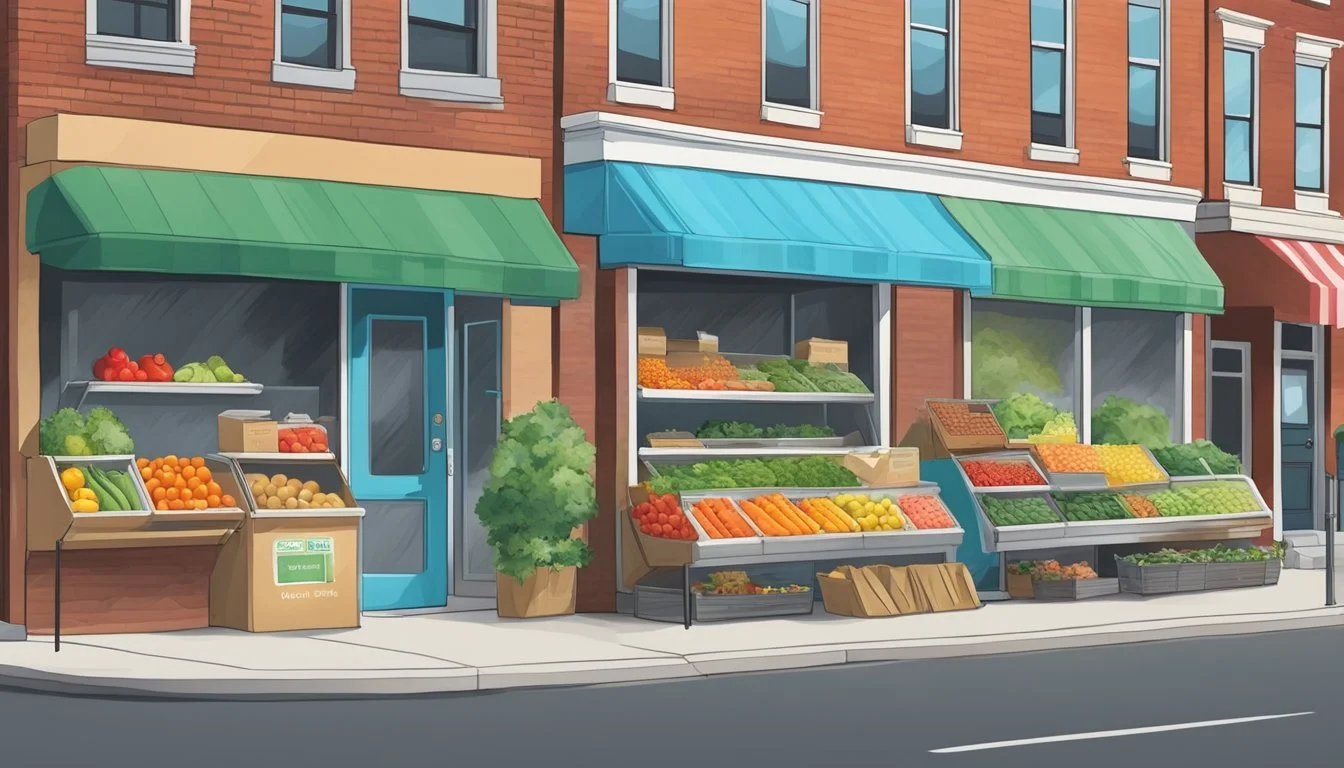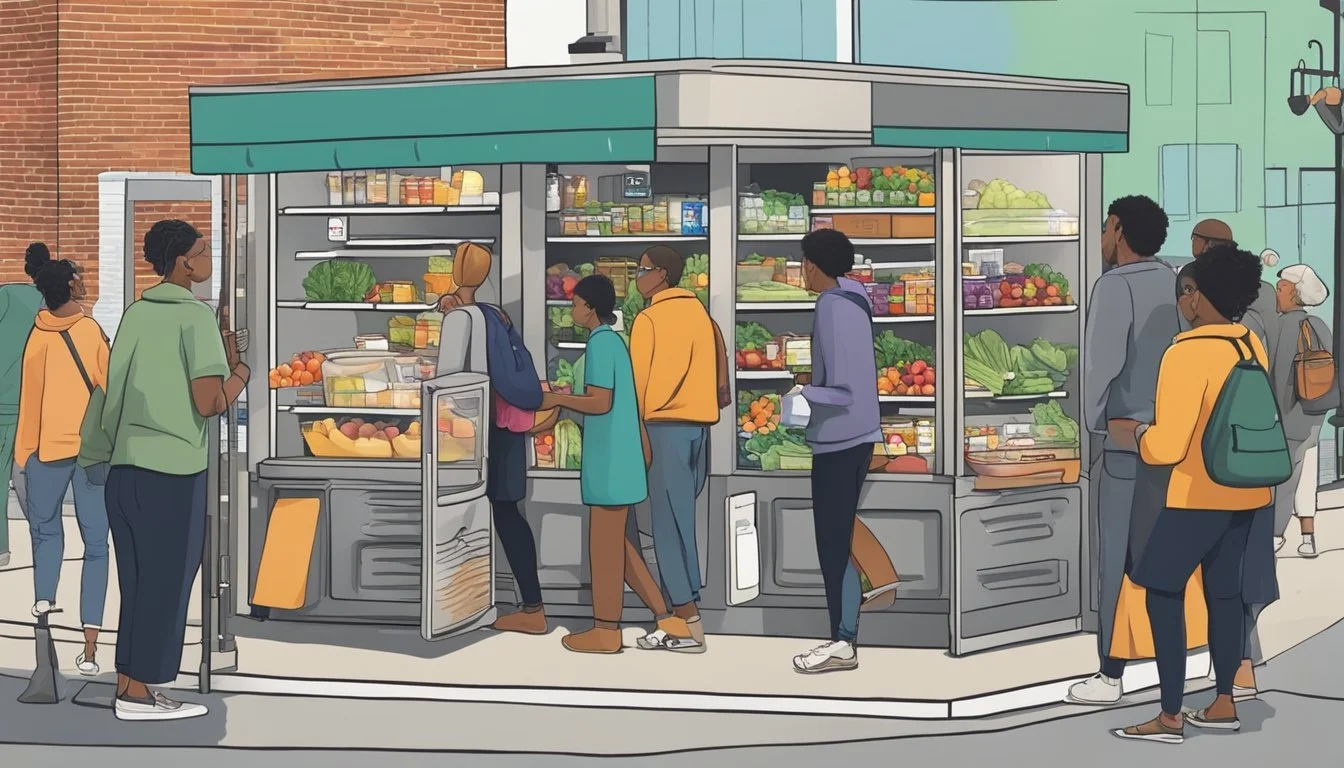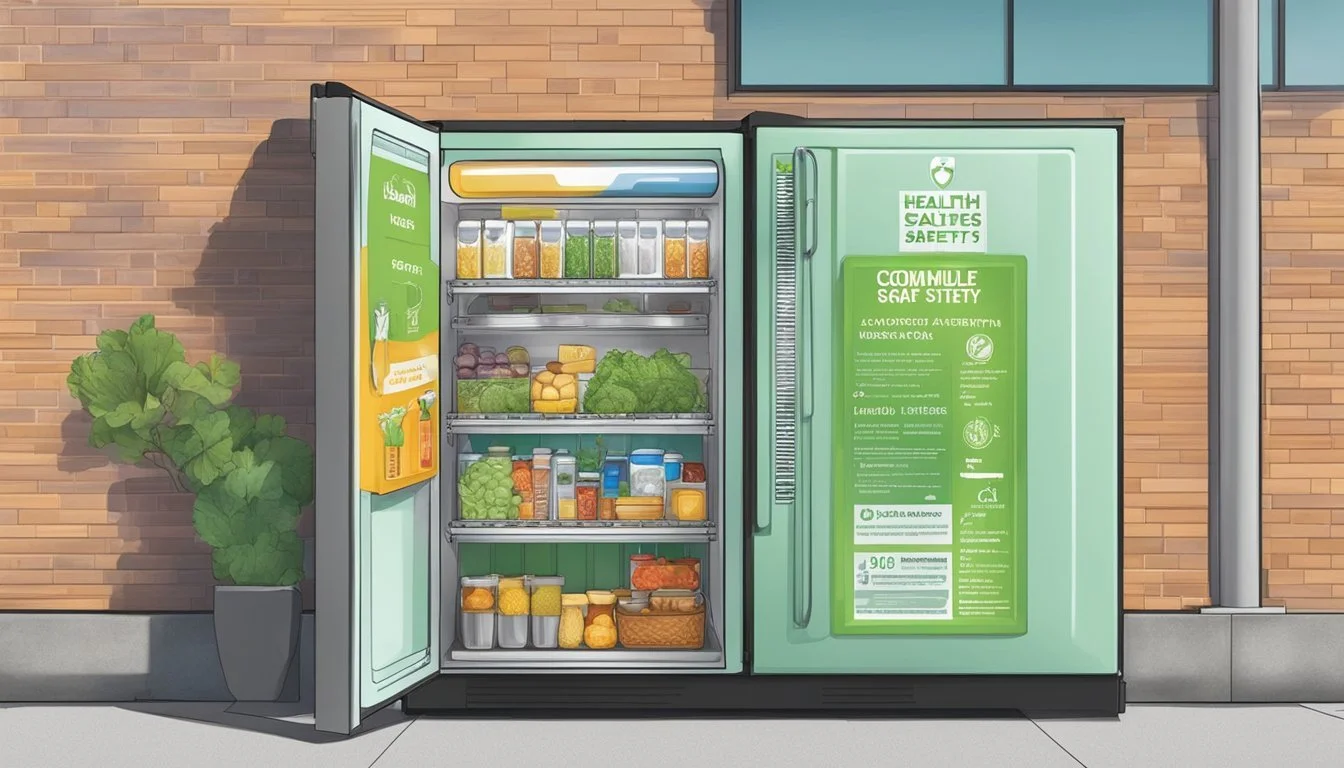Columbus, OH Community Fridge
Nourishing Neighborhoods Together
In Columbus, Ohio, the community fridge initiative is a step toward addressing food insecurity and reducing food waste. These refrigerators, strategically placed in accessible locations, provide a place where individuals and businesses can leave surplus food for those in need. It's a simple concept: take what you need, leave what you can. The presence of community fridges in Columbus is a testament to the city's commitment to fostering communal support and sustainability.
The fridges operate on the principle of sharing and caring within the community. They are often managed by local organizations or groups of volunteers who maintain the fridges and ensure that the food shared is safe to consume. The community fridges are typically stocked with fresh produce, meals, and other perishable items, making nutritious food more readily available to everyone, especially to those who might not have sufficient access otherwise.
Columbus's network of community fridges is not just about food; it's a hub of community interaction and solidarity. These collective efforts not only provide immediate relief to hungry individuals but also bring awareness to the larger systemic issues of food waste and food insecurity. The intentional placement in Franklin County allows the initiative to reach diverse populations, fostering an environment where the act of sharing is as nourishing as the food provided.
Understanding Community Fridges
Community fridges are a novel innovation aimed at addressing food insecurity by providing fresh food access to all members of the community.
What Are Community Frididges?
Community fridges, often referred to as freedges, are publicly accessible refrigeration units where community members can leave or take fresh food. These units operate on an honor system, fostering a shared responsibility among community residents. They offer a straightforward solution for sharing surplus food, thereby reducing waste and enhancing food availability.
The Role of Community Fridges in Food Security
Community fridges play a critical role in food security, particularly in urban areas like Columbus, OH where access to affordable nourishment can be challenging. They operate under the principle of Food for All, providing an inclusive, stigma-free means of acquiring groceries, particularly for those facing economic hardship. By offering fresh food directly to those in need, community fridges bypass many of the logistical challenges associated with traditional food aid programs.
Community Fridges Vs. Traditional Food Aid
Feature Community Fridge Traditional Food Aid Access 24/7, no questions asked Limited hours, often requires registration Food Type Mainly fresh, perishable items A mix of perishable and non-perishable items Distribution Self-service Distributed by volunteers/employees Scope Hyperlocal Local, regional, or national
Community fridges distinguish themselves from traditional food aid through their focus on perishable, fresh food and their easy, stigma-free access. While traditional food aid might include a structured system of needs assessment and distribution schedules, community fridges are designed to be more spontaneous and responsive to immediate needs, reflecting a grassroots approach to food insecurity in the community.
Establishing a Community Fridge in Columbus, OH
Establishing a community fridge in Columbus, OH requires careful planning, adherence to legal guidelines, and a committed team. The city's vibrant community spirit is an asset in creating a project that addresses food insecurity and reduces food waste.
Choosing the Right Location
The project begins with identifying a strategic location in Columbus that is both accessible and visible to the public. A successful location is often outside a business or community center that supports the initiative by providing space and electricity for the refrigerator. The location must be within reach for those in need while ensuring that it doesn't impede local businesses or residents.
Securing Permits and Legal Considerations
Before the refrigerator can be installed, the project team must navigate Columbus's legal landscape by obtaining the necessary permits. This includes health and safety regulations that ensure the community fridge operates within Franklin County’s health guidelines. It’s vital to establish contact with local authorities to gain an understanding of any zoning or public use restrictions.
Building a Project Team for Success
Assembling a dedicated project team is crucial for the community fridge’s longevity. Leadership roles must be established to manage operations, oversee food safety, and coordinate with volunteers. The team must also maintain accurate contact information to streamline communication. Engaging with community stakeholders and social innovators early on fosters a collaborative effort that underpins the project’s success.
By focusing on these pivotal steps, Columbus can build a community fridge that serves as a beacon of support and an example of practical solidarity in addressing food scarcity challenges.
Operational Aspects of Community Fridges
Community Fridges in Columbus, Ohio, require systematic routines to ensure safe food sharing and hygienic conditions. They rely heavily on coordinated efforts from volunteers and generous food donations from individuals and businesses.
Maintenance and Cleaning Protocols
The refrigerators must be cleaned and maintained regularly to keep food safe. Volunteers are scheduled to clean the interior and exterior surfaces using paper towels and cleaning solutions approved for food safety. Thermometers are placed in each fridge to continuously monitor the temperature, which is crucial for preventing foodborne illnesses. A trash can is stationed nearby for immediate disposal of waste to maintain cleanliness.
Tasks include:
Wiping down surfaces daily
Checking and recording temperatures
Disposing of expired or spoiled items promptly
Managing Food Donations
Managing food donations involves ensuring the quality and safety of the food and drinks offered. Donations are accepted according to guidelines, which typically exclude perishable items prone to rapid spoilage. Volunteers inspect the donations to verify their suitability before placing them in the fridge.
Donations checklist:
Sealed and labeled properly
Not past their expiration date
Free from damage or contamination
Volunteer Coordination and Responsibilities
Volunteers form the backbone of the Community Fridge operations. They have clearly defined roles and responsibilities, from managing donations to maintaining the fridges. Every volunteer is trained to understand the importance of their duties, and schedules are in place to ensure that all tasks are covered throughout the week.
Responsibilities include:
Stocking the fridge with acceptable items
Routine checks for the integrity of donations
Regular communication with the team for any urgent needs
Through these operational protocols, Community Fridges in Columbus ensure they serve their purpose efficiently and safely.
Community Engagement and Collaboration
Community Fridge initiatives in Columbus, OH, have seen significant advancements through strategic partnerships and cooperative efforts that aim to address food insecurity and waste. These efforts bring together diverse groups and resources for the collective benefit of the local population.
Working with Local Businesses and Neighborhoods
Local businesses in Columbus have shown strong support for community fridges by providing surplus food items that would otherwise go to waste. These businesses, in collaboration with neighborhood associations, play a critical role in supplying the fridges with fresh and nutritious food options. Such partnerships help sustain the fridge networks and ensure they are stocked with a variety of food to meet community needs.
Key Partnerships
Restaurants and grocery stores for regular food donations
Neighborhood associations for fridge locations and local volunteers
Fundraising and Resource Allocation
To maintain and expand community fridge operations, continuous fundraising efforts are essential. Resources are gathered through:
Community donations
Grants from local organizations
Support from city initiatives
A transparent budget allocation system is in place to ensure that all donated funds are used effectively. This includes covering costs like fridge maintenance, electricity, and the replenishment of perishable goods.
Promoting Inclusion and Diversity
Community fridges in Columbus serve as a reflection of the city's commitment to inclusion and diversity. They are located in diverse neighborhoods, ensuring access to fresh food across various socioeconomic backgrounds, including the Black and white communities. Initiatives to promote inclusion also involve educational outreach, aiming to dissolve any potential stigmas associated with using the fridges.
Efforts to Promote Inclusive Use:
Placing fridges in accessible locations across different neighborhoods
Culturally sensitive food stocking to cater to diverse dietary preferences and traditions
Health and Safety Regulations
Columbus, OH Community Fridges operate under strict health and safety regulations to protect the community, particularly those who are food insecure. These regulations ensure that the food provided through the fridges is stored and handled safely, minimizing the risk of foodborne illnesses.
Ensuring Safe Food Handling
Temperature Control: Food items are kept at a safe temperature, below 41°F, to prevent bacterial growth.
Storage Practices: Foods are stored in a manner that prevents cross-contamination, with ready-to-eat foods separated from raw items, and all foods are stored at least 6 inches off the floor.
Handling and Preparation: Volunteers and staffers handling food are trained in proper hygiene and safe food handling practices, ensuring that all items distributed through the community fridges are safe for consumption.
Collaboration with Health Departments
Inspections: The Columbus Department of Public Health regularly inspects the Community Fridges to ensure compliance with food safety regulations.
Guidance and Training: They provide guidance and training resources to guarantee that the fridges are a safe source of food for the food insecure individuals they serve.
Marketing and Outreach
The success of the Columbus, OH Community Fridge hinges on effective marketing and outreach strategies that engage the community and raise awareness. This involves leveraging social media platforms, educating the public, and building a recognizable brand for the fridge.
Utilizing Social Media
The organization maintains a strong presence on platforms like Instagram, where they regularly update the community with news and information about the community fridge. Social media serves as a critical tool in rallying volunteers and donors, showcasing the impact of the fridge, and encouraging community participation. The use of hashtags and the creation of a visual narrative around the initiative helps in keeping the audience informed and engaged.
Community Outreach and Education
Community outreach programs are in place to promote the concept of food sharing and to reduce food waste. They have designed a community outreach toolkit to assist volunteers in spreading the word about the community fridges effectively. Educational materials are distributed, and events are held to enlighten community members about how they can contribute to or benefit from the fridge, ensuring a well-informed public.
Building Brand Awareness for the Fridge
Brand awareness is built through a clear, consistent message about the community fridge's role and benefits. The messaging is aimed at highlighting how the fridge addresses food insecurity and supports sustainability. They create and distribute marketing materials, both online and in the local area, to maintain visibility and drive the engagement necessary to sustain this community-driven project.
Challenges and Solutions
Community fridges in Columbus, Ohio, face specific challenges that require practical solutions to ensure their effectiveness in addressing hunger and food waste.
Addressing Vandalism and Theft
Vandalism and theft are significant concerns for community fridges. To counter these issues, organizers have employed strategies to make the fridges safe and secure. Measures include the installation of surveillance cameras and community patrols. In terms of decision making, community involvement is crucial, with local residents often volunteering to monitor and maintain the fridges.
Security Measures Installed:
Surveillance Cameras
Regular Community Patrols
Sustainability and Long-Term Planning
Ensuring the sustainability of community fridges involves both logistical and financial planning. Organizers work on establishing relationships with local businesses and farms to keep the supply of food steady. Additionally, strategies are put in place for funding and maintenance, ensuring the fridges are operational for the long term.
Sustainability Strategies:
Partnerships for Supply:
Local Businesses
Farms
Maintenance and Funding:
Scheduled Check-ups
Community Donations
Case Studies and Success Stories
Communities across Columbus, Ohio, are actively addressing food insecurity through innovative fridge initiatives. They not only tackle waste but also serve as a case study for communal harmony and resource sharing.
Columbus Community Fridge Initiatives
Columbus is home to several community fridge projects aimed at providing fresh food to those in need. One standout initiative is the Community Fridge Columbus program, which operates with a simple but powerful ethos: "Take what you need, leave what you can." This principle has fostered a space for mutual aid where residents can either donate or take food items, thus addressing issues of food insecurity directly within the community. The initiative finds a tangible manifestation at locations like the Riverview International Center, which supports the integration of immigrants and refugees into the Columbus fabric through various services, including food assistance.
Comparison with Other Cities' Community Fridges
Comparing Columbus to other cities, such as New York City, which has its own robust network of community fridges, reveals similarities in objectives and challenges. Both cities' fridges operate on a take-what-you-need basis, contributing to the reduction of food waste and improving community food access. However, Columbus differentiates itself through the integration of these fridges into broader community action plans, such as the CBUS Action Plan, which emphasizes collaborative efforts and innovative strategies for urban development. This plan highlights a comprehensive approach to tackling social issues by leveraging community efforts, including those surrounding the access to food and drinks.
Getting Involved
Participation in the Columbus Community Fridge project is crucial for its success and sustainability. Potential volunteers and donors are the backbone of this initiative, ensuring that good food is shared and not wasted.
How to Donate or Volunteer
Donating to the Community Fridge:
Individuals can donate food directly to the community fridge locations. It is important to ensure that donations are non-perishable goods or fresh produce that is still within its usable lifespan.
Businesses and local food producers are encouraged to contribute surplus stock that would otherwise go to waste, thereby supporting the community and reducing food waste.
Volunteering Opportunities:
Volunteers can engage in various activities such as stocking the fridge, cleaning, and ensuring the donated items meet health and safety standards.
Outreach is another critical area where volunteers can help, by spreading the word about the community fridge and educating the public on how to participate effectively.
Joining the Movement for Community Support
The movement for community support extends beyond individual volunteering and donating actions. It encompasses a collective effort aimed at alleviating food insecurity and promoting sustainable food sharing practices.
Those interested in being part of this larger movement can join existing community support initiatives in Franklin County.
Social innovators and organizations can also participate by starting a new community fridge, thereby scaling the impact within Columbus and its surrounding areas.
Each contribution, regardless of its size, plays a significant role in strengthening the Columbus Community Fridge network and fostering an environment of shared responsibility and support.
Conclusion and Future Directions
Columbus CEO's Future 50 initiative has successfully positioned itself as a formidable force in combating food insecurity by launching the community fridge project. Their approach has strategically involved installation of community refrigerators in areas of need, ensuring accessibility to fresh produce and prepared foods for those most vulnerable.
Moving forward, the emphasis is on sustainability and expansion. The team aims to maximize community engagement and support, inviting residents and businesses to participate through donations and collaborations. This collective effort underscores the importance of a unified front against hunger.
Elected officials have recognized the significance of such grassroots projects and are exploring methods to integrate these initiatives within broader city agendas. This could lead to policy development that supports community fridges and similar programs.
As for future directions, there's a clear path for growth:
Assessing Impact: Continual evaluation of the project's reach and efficacy in serving the community.
Expanding Network: Identifying new locations for fridge installations to ensure no neighborhood is left behind.
Consistent Funding: Establishing stable funding channels to maintain and scale the project.
Leaders within the Future 50 are responsibly charting courses for the next phases, including the possibility of nurturing the concept into a model that could be replicated in other communities. Through transparency and responsible governance, they are set to bolster Columbus's role as a leading example of community-driven solutions to food access.
Appendix
This section provides additional details related to the support infrastructure and operational nuances of Columbus, OH's Community Fridge program.
Supplementary Information
When managing a community refrigerator, it's essential that food safety and preservation are prioritized. To that end, items like zip lock bags and garbage bags are regularly used to ensure food remains protected and waste is managed appropriately. Diatomaceous earth may be utilized around the site to deter pests without using harmful chemicals, acknowledging the importance of maintaining a sanitary space.
With a mission to alleviate hunger, especially among the homeless and shelterless populations, the Community Fridge often provides more than just the next meal. In Columbus, local initiatives sometimes include kids involved in community service, reinforcing youth participation in local solutions. Handpicked as core 4 leaders are individuals, possibly including local artists, who showcase a strong commitment to their community.
Critical to the project’s success is the choice of the fridge's location. It operates on a private residence or a business front, with permission granted by property owners. These spaces serve as accessible points for those in need, as well as for those providing hands-on efforts to stock and maintain the fridge. For example, Jordan Tuss in Cincinnati has been noted for work in launching similar projects in areas like Over-the-Rhine, fostering a strong sense of community and support during events like the COVID-19 pandemic.
Named Freedges, these community fridges are not only about providing food but also cater to additional necessities such as clothing, following a trend seen in other cities. Local artists have been known to contribute by beautifying the spaces, often transforming the fridges themselves or their accompanying blue carts into works of art. In Columbus, adequate lids and labels are essential for maintaining the fridge, keeping food fresh and signaling clear usage guidelines to the community.
Operational support often includes corresponding with city services, such as refuse collection and RecyColumbus, to ensure the site aligns with local recycle right policies. This collaboration helps manage food waste, with some fridges even receiving donations from restaurants looking to contribute to those in need rather than disposing of excess food.
By carefully managing these aspects, the community fridge project in Columbus continues to support the less fortunate, working diligently to extend the reach of their compassionate service.













